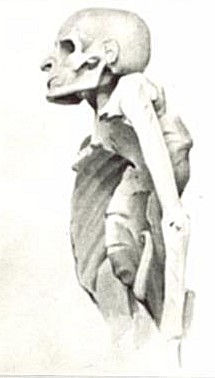This article includes a list of general references, but it lacks sufficient corresponding inline citations. (August 2020) |
| Pott's disease | |
|---|---|
 | |
| Tuberculosis of the spine in an Egyptian mummy | |
| Specialty | Rheumatology |
| Symptoms | Pott's spine, tuberculous spondylitis, spinal tuberculosis |
| Diagnostic method | Radiograph, Bone scan, MRI |
| Named after | Percivall Pott |
Pott's disease, or Pott disease, named for British surgeon Percivall Pott who first described the symptoms in 1799,[1] is tuberculosis of the spine,[2][3] usually due to haematogenous spread from other sites, often the lungs. The lower thoracic and upper lumbar vertebrae areas of the spine are most often affected.
It causes a kind of tuberculous arthritis of the intervertebral joints. The infection can spread from two adjacent vertebrae into the adjoining intervertebral disc space. If only one vertebra is affected, the disc is normal, but if two are involved, the disc, which is avascular, cannot receive nutrients, and collapses. In a process called caseous necrosis, the disc tissue dies, leading to vertebral narrowing and eventually to vertebral collapse and spinal damage. A dry soft-tissue mass often forms and superinfection is rare.
Spread of infection from the lumbar vertebrae to the psoas muscle, causing abscesses, is not uncommon.[4]
- ^ Tuli SM (June 2013). "Historical aspects of Pott's disease (spinal tuberculosis) management". European Spine Journal. 22 (Suppl 4): 529–538. doi:10.1007/s00586-012-2388-7. PMC 3691412. PMID 22802129.
- ^ Garg RK, Somvanshi DS (2011). "Spinal tuberculosis: a review". The Journal of Spinal Cord Medicine. 34 (5): 440–454. doi:10.1179/2045772311Y.0000000023. PMC 3184481. PMID 22118251.
- ^ Pott Disease (Tuberculous Spondylitis) at eMedicine
- ^ Wong-Taylor LA, Scott AJ, Burgess H (May 2013). "Massive TB psoas abscess". BMJ Case Reports. 2013: bcr2013009966. doi:10.1136/bcr-2013-009966. PMC 3670072. PMID 23696148.